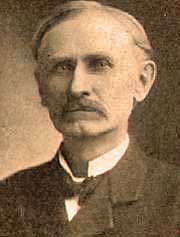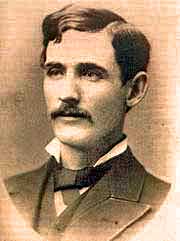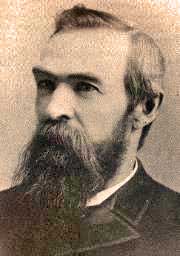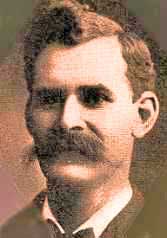 Churches of Christ & Christian Churches in the Pacific Northwest -- MONTANA -- |

Oct 8, 2009 |
Anaconda | Bozeman | Butte | Cascade | Corvallis | Deer Lodge
Fish Creek | Hamilton | Helena | Highwood | Kalispell
On to Wyoming . . Pioneer Menu . . Search - - Oldest presented first.
Montana Pioneer |
|
|
|
A wealth of information comes from the Big Sky Disciples by Merrill G. Burlingame and Harvey C. Hartling, written in 1984. It is both well-researched and well-written with ample footnotes and excellent bibliography. The 318 page book is published by the Christian Church in Montana.
Some of our photos have come from the vintage postcard trade. We have daily contact with dealers and purchase pictures of early church buildings. Some photos on our pages have been taken from vintage dinner plates.
Our last major source of facts comes from the speech presented in 1902 by Walter Marion Jordan when he was President of the Montana Christian Association. The document has been provided to us by Ronald H. McConkey.
The Montana Difference. While the primitive gospel rode into Oregon in the ox-carts and hearts of farmer-preachers, the men evangelizing Montana were more often college-trained and partially supported by Christians outside of Montana. The population of Oregon was quite stable compared to the men working the mines of Montana. This constant moving, in turn, led to a large turnover among the churches. One would flourish for a few months, or even several years, then decline -- and even close.
The buildings were different. In Oregon and Washington, the earliest buildings were simple frame structures, often one large room. They were usually paid for by the time they were dedicated to the service of God. If any debt was owing on Dedication Day, the celebrating visitors took up an offering and paid off the remaining balance.
A few simple buildings were constructed in Montana such as Anaconda, Highwood and Cascade. But many were ornate and elaborate for the times. Perhaps the weather was a factor, perhaps the educational background of the preachers or a sense of being competitive with the denominations in facilities. At any rate, excessive building debt was an early discouragement for the developing congregation. Most congregations survived, but the debt may have dampened early development.
Walter Jordan, in his speech of 1902 said:
We made an awful mistake in the beginning and we are suffering today on account of that blunder. Our first evangelists labored under the delusion that the first great need of a mission church is a fine house of worship, so they built great big expensive houses of worship for which they could not possibly pay and left our poor mission churches burdened with debts under which they have been groaning in some cases for several long years.Now we begin with the cities, starting with the earliest.
Helena Mapquest
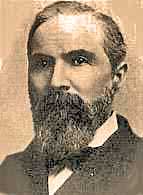 |
Because T. F. Campbell was the first to immerse a candidate in water in Montana (James T. Thorpe), the church must have consisted of disciples who moved in from Tennessee, Kentucky and Missouri. Campbell practiced law and operated a boys home at one time.
In 1868 T. F. Campbell was appointed Territorial Superintendent of Schools but the very next year he was offered the Presidency of the new Christian College at Monmouth, Oregon and left Montana.
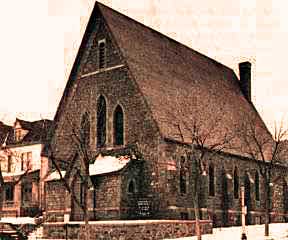 |
Power Street and N. Benton Avenue Courtesy of the Christian Church in Montana |
There is a profile of T. F. Campbell.Like many pioneer era churches, there were several startup dates for the Helena Church. A group would form, then fail, then form again. This makes pinpointing a precise date a judgment call. For this reason, our dates are sometimes earlier than the date selected by the local congregation because they pick the date of the last startup and we focus on the earliest event.Walter Jordan, in his speech of 1902 said:
For a long time the brethren in Helena continued to meet from house to house on the Lord's day for communion and exhortation. At these Social meetings occasionally a sinner would confess his faith in Christ and become a candidate for baptism. One of the little company, usually Brother J. H. Smith . . . would be appointed to officiate as the baptizer, and with rejoicing they would repair to some convenient stream, to witness the burial in the watery grave and the resurrection to walk in newness of life.
Early Ministers: Thomas F. Campbell
Gustavus A. Hoffman
J. Z. Taylor
Martin L. Streator
George K. Berry
J. N. Smith
John M. Streator
Walter M. Jordan1864 -- 1869
1879 -- 1881
1882
1883 -- 1888
1888 -- 1890
1890 -- 1892
1895 -- 1896
1899 -- 1904In 1883 the church was meeting in the court house. Martin L. Streator wrote to the Pacific Christian Messenger that year:
For the present, we are meeting in the court house, where all the churches in Helena began their public work. The Baptists who are now meeting in the Southern Methodist church, will remove in a month or two into a new house of their own. We then will occupy the vacated house until ours is ready for use, which probably will be next fall.Our audiences are very small, but we hope for an increase when we can hold our meetings in a church building.

G. K. Berry About 1888, George K. Berry moved his new wife Ida to Helena. The Christian Standard of September 21, 1889 says "He successfully met A. D. Raleigh, D.D. of the M.E. Church, in religious discussion in Helena, February, 1889."
A Virginian, Mr. Berry had graduated from the Christian University (now called Culver-Stockton College) at Canton, Missouri before moving to Montana. He moved on to Portland, Oregon in the summer of 1890.
By 1890, J. N. Smith was living and preaching in Helena. His ministry was short and ended in controversy. He moved on to the coast states. The church did not have a preacher for three years.
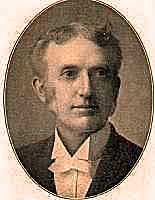
J. M. Streator Jonathan M. Streator was the minister from 1895 to 1896. Mr. Streator had become interested in Helena through the efforts of his brother Martin who had preached there earlier.
He had been born near the heart of the American Restoration Movement in Washington, Pennsylvania and had attended Alexander Campbell's Bethany College, graduating in the class of 1866. After leaving Helena, he preached other places in the midwest, then returned to Bethany College as a professor of Latin.
Deer Lodge Mapquest
One source says, "Deer Lodge earned its name from a thermal spring that gave off large amounts of vapor and built up a cone almost 40 feet high. From a distance the cone and vapor resembled an Indian lodge with smoke rising from it. Many deer often frequented the area to feed; thus, the name Deer Lodge."
Early Ministers: Gustavus A. Hoffman
Wiley Mountjoy
Galen Wood
R. E. Dunlap
Owen J. Gist
A. B. McFarland
Walter M. Jordan1879
1880 -- 1882
1883 -- 1886
1886 -- 1889
1889 -- 1891
1893
1894 -- 1898The congregation was organized in 1880 under the direction of Wiley Latham Mountjoy. Mountjoy was a graduate of Christian University in Canton, Missouri.
Mr. Mountjoy was a native of Kentucky and married to Mary Ella Irvine. The Mountjoys had four children when they arrived in Montana.
Charter members included: Zona and Sallie Battenton, Marjorie Hod, Newmeris, Robert and Mary Humber, Lydia and Thomas Irvine, John and Annie Williams.Some preliminary work of making disciples in Deer Lodge had already been done by German-born Gustavus A. Hoffman in 1879. He was also from Christian University in Missouri. Prior to Mr. Mountjoy's arrival twenty-two were immersed into Christ, 42 transferred from distant congregations of the New Testament order and two were from the Baptist church.
Deer Lodge Christian
Church in 1889Mr. Mountjoy remained two years and was followed by Galen Wood. Mr. Wood remained for three years. It was during this time they built their gothic style brick building.
On the 1894 map, the building was located at 4th and D St. (600 4th.) These streets were renamed so the church was at the southwest corner of Montana Avenue and 4th. A few years later the steeple was removed, leaving only the bell tower.
By 1886, R. E. Dunlap had arrived and was leading the group. He succeeded Galen Wood at Deer Lodge, remaining about three years. His ministry was vigorous and successful, with special attention to the youth. In this Mrs. Dunlap took strong leadership. She made as many as sixty calls a month on Sunday School promotion, said Dunlap, while he made only forty calls for the church.
Corvallis Mapquest
Originally called Chaffinville, Corvallis had been renamed by the time W. D. Lear came to the Valley in 1880 to establish a church after the New Testament order.
Walter Jordan reported of W. D. Lear:
He took up the work simply begun by Brother Hoffman, and, with the help of his brethren, succeeded in building the first house of worship ever erected in Montana by the Disciples of Christ.
Francis L. Cook
The Corvallis church secured the services of H. G. Horn in 1886. He was a capable man but after seven months of labor, sickness caused him to quit preaching entirely. After it was decided that he could not recover, C. G. (Editor: C.J.) Wright of Washington, was employed. Brother Wright was a strong-man, spiritually and intellectually, but after working four months he too was confined to his bed. Two invalid preachers were then cared for until the spring of 1888, when death took them both almost at the same time. They were both buried on the same day. Be it said to the everlasting credit of the Corvallis church that besides caring tenderly for each of these brethren till death, each man received a full year's salary while one worked but seven months and the other but four.
There is a profile of C. J. Wright.
The minister beginning in 1892 was the music-loving Francis L. Cook. Part of his time was spent with John F. Ghormley holding gospel meetings, but when he was home, he conducted singing groups several nights each week.
By 1894 the Sunday morning choir alone numbered 110 -- and that in Montana where total attendance was usually less than 100. Because of the pack-out audiences, Cook and B. F. Norris began promoting a plan for another congregation at Hamilton, a few miles away.
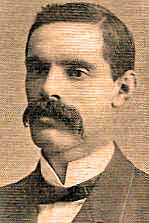 |
James A. Seaton began his work at Corvallis in January of 1889. He and his wife Mary were hard working people who seldom vacationed.
By 1903, John D. Stephens of Ontario, Canada was the minister. Born in 1861 and immersed into Christ in 1878, he had studied at Bethany College in West Virginia. He was married to Mary S. Hyatt.
Early records shows that Mr. Stephens divided his time between the Corvallis and Florence churches.
In 1905 John Stevens moved to Whitehall, Montana where he preached for the Christian Church.
The church building was located at the southwest corner of the intersection of 2nd and College (Eastside Highway).
Anaconda Mapquest
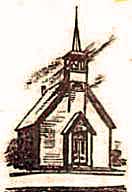 |
Church 1889 |
That same year, the first service held in the town was held by Galen Wood in the month of February. The house of worship, costing $2,000, was dedicated and a church of seven members was organized in July of the same year.
By 1889 the number of disciples enrolled had risen to 23. Preachers prior to 1889 included E. O. Sharpe from Illinois and J. L. Phoenix from Pennsylvania.
G. O. Black came as minister in 1893 and a gospel meeting was planned with John Fletcher Ghormley. The seating was enlarged to handle 400 and 47 were added during the meeting. The building was then sold and another built to replace it.
| Early Ministers: | |
|
E. O. Sharpe J. L. Phoenix Galen Wood B. P. Norris A. B. McFarland George Barnaby |
1884 1884 1886 1890 -- 1891 1893 -- 1894 1894 -- 1897 |
In 1891, the building was located at the intersection of E. Park and Cherry. (Actually one lot east of the intersection on the south side of E. Park.)
Later the building was at E. 6th and Cedar.
This writer's personal friend Clarence Boulton preached in Anaconda about the time this writer was born.
Missoula Mapquest
 |
| Eli Fisher |
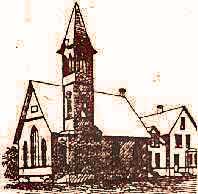 |
| The Church of Christ
at Missoula - 1889 |
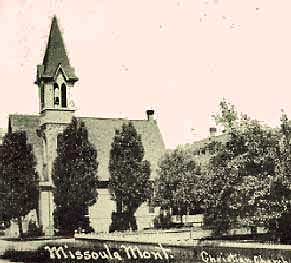 |
after the trees grew, 1908 |
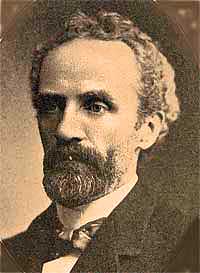 |
|
Gilbert E. Ireland
|
William D. Lear arrived in 1884 to launch a congregation after the model of the church in the book of Acts. John L. Phoenix was briefly associated with the emerging church and then Eli Fisher arrived in 1887 to build the congregation.
The earliest meetings were held in an old carpenter shop. Work on a meeting house started in 1888 and was nearly completed by the Fall of 1889.
An eye witness described the building:
The audience room is 31˝ x 57˝ feet, with dressing rooms and parlors in the rear, one and one-half stories high; basement under whole building unfinished. The tower at southeast corner is 9 x 12 feet, first story, and 9˝ feet square the remainder. The whole is frame with brick veneering, finished with Missoula pine and Oregon fir, in hard oil. Its acoustic properties are excellent . . .The added building to the rear in the drawing is the parsonage that was constructed by Eli Fisher. It eventually was owned by the church and was converted to classrooms and offices.
The building was located at the north corner of East Broadway (then called Cedar) and Washington. In the drawing, the artist is showing the Washington Street side.
Walter Jordan reported:
Eli Fisher closed his work in Missoula in the fall of '91. G. E. Ireland was his successor and began his work in the spring of '92, and continued until the close of '95. He was a thoroughly good man and a most excellent and energetic pastor. . . .The Missoula church has had' reason to prosper during the past seven years. They have had a good ministry. The eloquent R. H. Sawyer served them two years. Then J. C. B. Stivers gave them two years of good preaching and diligent pastoral care. James Egbert remained with them less than a year, but he was a genuine man, and now H. E. Kossell has been with them almost two years and he has been strong in every way—a good preacher, a wise and industrious pastor and a first class manager. No wonder that the last year has been possibly the best in all the history of the Missoula church.
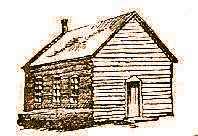 |
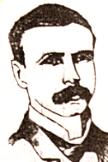 |
Canadian-born Benjamin F. Norris was then employed as a school teacher in that valley and preached for the little church for more than two years. Mr. Norris had attended Oskaloosa College in Iowa. It was during his stay that the building was constructed and 11 were baptized into Christ.
M. L. Streator described the building as 30 feet by 18 feet with a 11˝ foot height. He said that it was a a log building, but "is the neatest log house I have ever seen." The interior was carpeted.
The population declined and eventually the church closed.
Cascade Mapquest
 |
In 1914 the building was located on the corner of Central Avenue and 2nd West. It is best described as the southwest corner of the intersection.
The founding minister was Benjamin F. Norris. Here, as at Highland, he was teaching school and shepherding the believers. He wrote in 1889:
Last year we began the erection of a church house, and now we have the only church edifice as well as the only church organization in Cascade or vicinity. . . .Walter Jordan, in his speech of 1902 said:
At this time there were about twenty-five members at Cascade who helped build the church, but there were two of them who were of such decided help to Brother Norris that we wish to mention their names. One was Mrs. Minnie Gorham, whose kind hospitality and hopefulness was always an inspiration to her pastor, and she helped in soliciting funds for the building. Mrs. Gorham has long ago been called to her reward, but her daughter Mrs. Lela Koberts continues (to be?) a living benediction to the Cascade church and community. The other name deserving mention is that of F. S. Read, who gave more money than any other person.Walter Jordan preached his first sermons here and remained about one year. After leaving nine months to attend Cotner University in Nebraska, he returned having married Ella Dungan, daughter of D. R. Dungan, the Chancellor. The year was 1892.
Fish Creek was about 10 miles SE of Whitehall, Montana. While it was a farming area, the possibility of mining held out hope for a better economy.
The congregation was organized by J. L. Phoenix in 1885. Harrison Jordan was named an elder.
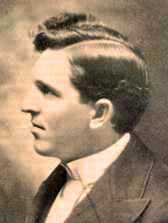 |
In our day of emphasis on church growth in numbers, this story is informative. It is about the Fish Creek church and was taken from the 1902 speech of Walter Jordan, son of elder Harrison Jordan:
The Brethren who heard Brother Hoffman preach, were inspired by his eloquence and holy zeal. I was a lad of about fifteen years of age when he held his short meeting at Fish Creek, but I remember that he made such an impression on my mind that I resolved to myself that whenever I did become a Christian I would join the Christian Church.A powerful voice for the Lord may never have become a leader in Montana if Mr. Hoffman had not held a meeting in this little place. Mr. Hoffman was good at reclaiming the strayed and establishing congregation, but he said, "So far as I recollect I only baptized four persons while in Montana. I think I rode three thousand miles horse back, and two thousand miles in the stagecoach to these different appointments."
In addition to Walter Jordan, Owen J. Gist, a young preacher among the Baptist churches came to understand the way of the Lord more completely. The most significant gains are not recorded by head counter.
Butte Yahoo map
Butte began as a cluster of mining camps during the early1870's. By the end of the decade, a large, bustling city had emerged. In 1879 the business district burned and the city council required that new buildings be of masonry.
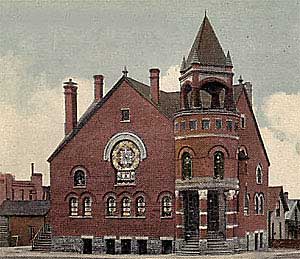 |
Gustavus Hoffman preached here twice in 1879 and located 16 Disciples. By the time Galen Wood began visiting regularly in 1887, he was aware of 40 Disciples.
His work was commended in the speech by Walter Jordan:
To establish the cause in Butte was a tremendous task. It was difficult to find a place of meeting. They met for a while in the Presbyterian church, then again at the Baptist church, later on at the Congregational church and finally at Fidelity Hall (58 West Broadway) where they had to pay large rent. A man of less endurance and patience than Galen Wood would certainly have failed in Butte, but he also had other qualities, he was a good scholarly preacher and very spiritual.The church completed its building in 1893 and some called it "the prettiest church in Butte, and probably in all Montana as well." By 1909, the bell tower had been built far above the roof line.
Bozeman Yahoo map
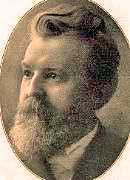 |
Abut 24 years later, the Lord brought his own trail blazer to this frontier town. Martin Lyman Streator was preaching at the Helena Christian Church at the time and was asked to assist in forming a new congregation. A group of disciples, largely from Missouri and Kentucky, formed a church with a charter membership of 34.
They layed plans to construct a frame building, but a generous gift from the Payne family enabled the planners to use brick. We believe this photograph is of the original building, although it was taken about 1920.
 |
The building was located at the southeast corner of West Babcock and Grand Avenue South.
The congregation has remodeled the building since it was first built, but the original structure can still be seen in the present one.
The first resident minister was Wiley Mountjoy, beginning in 1889. He is pictured in the Introduction at the top of the page.
Mr. Mountjoy stayed about one year, but before the church was two years old, it had 101 members.
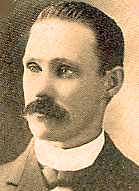 |
The minister in 1892 and 1893 was the highly effective John Fletcher Ghormley. Mr. Ghormley later moved to Walla Walla, Washington and Portland, Oregon.
Walter Jordan reported in 1902:
They had Wiley Mountjoy for a little over a year, B. E. Dunlap a year, J. A. Seaton about two years, J. F. Ghormley less than a year, E. T. C. Bennett one year, and just a few weeks before the annual convention of '95 they had employed O. F. McHargue whose ministry after seven years still continues.
Hamilton Mapquest
Hamilton was named after James Hamilton, the man who planned it. Hamilton is unique in that it didn’t evolve, but began as a planned town with wide streets and an economic center for the area farms and ranches. That was about 1894.
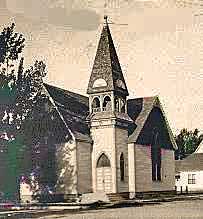 |
That next year, F. L. Cook, preacher at the nearby Corvallis Christian Church joined forces with B. F. Norris. They began a gospel meeting and established a church with 34 charter members.
The development company gave a plot providing that a building be put up immediately and this was accomplished with largely volunteer labor. The building was dedicated to the Lord in 1896.
It was located at 601 South 2nd, the southwest corner of Desmet and S. 2nd.
In addition to Norris, B. C. Black and R. M. Dungan led the work in its early days.
Lewistown Mapquest
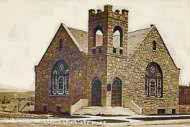 |
The church was reorganized in 1909 by Lawrence Wright and V. E Ridenour and there were about 33 members at this time.
The church built a handsome stone church in 1911. It was located at 623 West Boulevard Street. This was the east corner of W. Boulevard and 7th Avenue N.
However, there was something flawed about the foundation and the building was eventually declared unusable. After many years, other property was secured and the church continued.
Kalispell Mapquest
The beginnings of the Kalispell Church were three miles northwest at Spring Creek. A small group of Disciples assembled in the home of C. B. Bondurant as early as 1898. By the next year had built a small frame church building and reported 17 members.
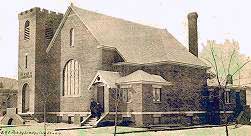 |
Meanwhile, the town of Kalispell began to emerge. One historical source says:
That summer of 1891 was the establishment of 23 saloons, half a dozen gambling joints, a like number of honky-tonks, two Chinese restaurants, two Chinese laundries, and four general stores.Christians in Kalispell first built at 2nd Ave. E and 7th Street East. The building was crowded onto the lot on the southeast corner of the intersection. The building shows on a 1903 map. The group was 40 in number.
Rapid growth soon demanded another building, so one was constructed at 2nd Avenue East and 3rd East. This time the building was on the northwest corner of the intersection. In 1909, the only other structure on the block was a bandstand immediately to the north.
Leaders involved in the earliest days of both congregations included Eli Fisher, J. F. Adair, Lawrence Wright and A. C. Downing.
In 1909 John L. Brandt conducted evangelistic services for the congregation. At that time Harold H. Griffis was the minister.
Next Chapter: On to Wyoming or back to Pioneer Menu

